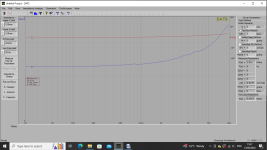I was wasndering how to interpret your reply Dave , do you mean the tweeter is measuring thus due to sticky ferro fluid
Do they make sound? Can you run a sweep at roughly 1 watt? Not seeing a FS peak would make me think stuck voice coil. If the Ferrofluid hardened it might do that. Another option is a pole piece shifted and the coil is stuck.
Hi there,
i have taken some impedance measurements of a pair of KEF SP1632 some time ago, here:

the coax tweeter impedance is very flat - extremely low Qts value
i have taken some impedance measurements of a pair of KEF SP1632 some time ago, here:
the coax tweeter impedance is very flat - extremely low Qts value
Thanks for all the input. Yes they make a sound when doing a sweep with DATS. Haven't measured FR yet or played music thru them. Doubt you'd get into them to check the ferrofluid. Look well sealed!
Seen small 3/4" or .75 to .8 tweeters with light mylar or polycarbonate cones and impedance peak is almost un seen.
But is a wide impedance bump from 700 to 1300 Hz. Be misleading if less visible thinking crossover could be low.
Just assume towards the top of the peak when seen.
This ones practical non existent but would assume towards the 1100 / 1200 Hz bump and you would cross it high
just like any other small tweeter 2.5 to 3k
Some Visaton small polycarbonate tweeters can surprisingly go pretty low without distortion at normal levels.
KEF might be the same.
But is a wide impedance bump from 700 to 1300 Hz. Be misleading if less visible thinking crossover could be low.
Just assume towards the top of the peak when seen.
This ones practical non existent but would assume towards the 1100 / 1200 Hz bump and you would cross it high
just like any other small tweeter 2.5 to 3k
Some Visaton small polycarbonate tweeters can surprisingly go pretty low without distortion at normal levels.
KEF might be the same.
- Home
- Loudspeakers
- Multi-Way
- what does this tweeter impedance curve mean?
